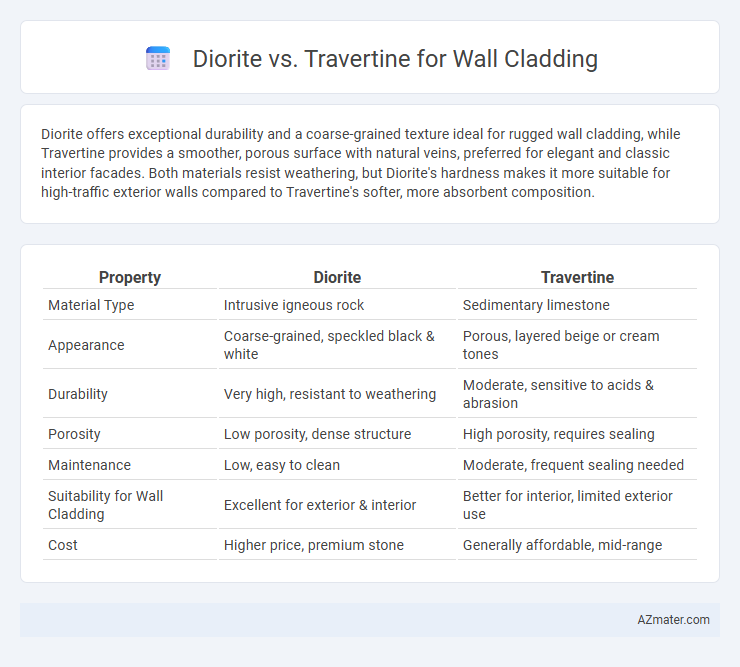Diorite offers exceptional durability and a coarse-grained texture ideal for rugged wall cladding, while Travertine provides a smoother, porous surface with natural veins, preferred for elegant and classic interior facades. Both materials resist weathering, but Diorite's hardness makes it more suitable for high-traffic exterior walls compared to Travertine's softer, more absorbent composition.
Table of Comparison
| Property | Diorite | Travertine |
|---|---|---|
| Material Type | Intrusive igneous rock | Sedimentary limestone |
| Appearance | Coarse-grained, speckled black & white | Porous, layered beige or cream tones |
| Durability | Very high, resistant to weathering | Moderate, sensitive to acids & abrasion |
| Porosity | Low porosity, dense structure | High porosity, requires sealing |
| Maintenance | Low, easy to clean | Moderate, frequent sealing needed |
| Suitability for Wall Cladding | Excellent for exterior & interior | Better for interior, limited exterior use |
| Cost | Higher price, premium stone | Generally affordable, mid-range |
Understanding Diorite and Travertine: Key Differences
Diorite, an intrusive igneous rock characterized by its coarse-grained texture and predominance of feldspar and quartz, offers exceptional durability and a speckled appearance ideal for wall cladding. Travertine, a form of limestone deposited by mineral springs, features a porous surface with natural pits and veins, providing a warm, classic aesthetic often seen in luxury interiors. Key differences include their formation processes, with diorite being igneous and dense, while travertine is sedimentary and porous, impacting maintenance requirements and overall visual texture in wall applications.
Geological Origins and Composition
Diorite, an intrusive igneous rock formed from the slow cooling of magma beneath the Earth's surface, features a coarse-grained texture rich in plagioclase feldspar and hornblende, making it highly durable and resistant to weathering in wall cladding applications. Travertine, a sedimentary rock primarily composed of calcium carbonate, originates from mineral-rich thermal spring deposits, characterized by its porous structure and distinctive banded patterns that offer a unique aesthetic but require sealing for enhanced durability. The contrasting geological origins result in diorite providing superior strength and minimal porosity, while travertine delivers a softer, more textured finish ideal for decorative indoor or outdoor wall surfaces.
Aesthetic Appeal: Color and Texture Comparison
Diorite offers a striking aesthetic appeal with its coarse-grained texture and a color palette ranging from dark grey to speckled black and white, providing a bold and sophisticated look for wall cladding. Travertine features a warm, earthy color spectrum including beige, cream, and honey tones, complemented by its naturally porous texture and distinctive vein patterns that add a soft, elegant ambiance. The choice between Diorite's dramatic contrast and Travertine's subtle warmth allows for diverse design expressions in interior and exterior wall cladding projects.
Durability and Strength for Wall Cladding
Diorite exhibits exceptional durability and high density, making it highly resistant to weathering and mechanical wear, ideal for long-lasting wall cladding applications. Travertine, while aesthetically appealing with its porous texture, is softer and more susceptible to erosion and staining, requiring regular sealing to maintain its structural integrity. For wall cladding projects prioritizing strength and minimal maintenance, diorite offers superior performance compared to travertine.
Weather Resistance and Longevity
Diorite offers superior weather resistance for wall cladding due to its dense, coarse-grained structure, making it highly durable against harsh environmental conditions such as rain, wind, and temperature fluctuations. Travertine, while aesthetically appealing with its porous texture, requires sealing to prevent water infiltration and is more prone to erosion over time. For long-term longevity in exterior applications, diorite typically outperforms travertine by maintaining structural integrity and appearance with minimal maintenance.
Maintenance Requirements: Diorite vs Travertine
Diorite wall cladding demands minimal maintenance due to its dense, hard composition, making it highly resistant to stains, scratches, and weathering. Travertine, a porous sedimentary stone, requires regular sealing to prevent moisture penetration, staining, and surface erosion, especially in outdoor installations. The upkeep for diorite is generally less intensive compared to travertine, which needs ongoing care to maintain its aesthetic and structural integrity.
Cost Factors and Installation Considerations
Diorite typically costs more than travertine due to its density and durability, which also affects transportation and handling expenses. Travertine's lighter weight and softer texture simplify installation, reducing labor costs and time compared to the harder, more brittle diorite that requires specialized cutting tools and expertise. Both materials demand sealing to prevent staining, but travertine often needs more frequent maintenance, influencing long-term cost factors for wall cladding projects.
Versatility in Architectural Styles
Diorite offers a dense, speckled texture ideal for modern and minimalist wall cladding, creating sleek, durable surfaces with a natural stone appeal. Travertine's porous, warm-toned surface complements classical, Mediterranean, and rustic architectural styles, adding timeless elegance with its varied patterns and earthy hues. Both materials provide versatility, but Diorite suits contemporary designs while Travertine excels in traditional and transitional aesthetics.
Environmental Impact and Sustainability
Diorite, a durable igneous rock, generally has a lower carbon footprint compared to travertine due to less intensive quarrying and processing methods. Travertine, a porous sedimentary stone, requires more energy for extraction and treatment to enhance its durability and appearance, potentially increasing its environmental impact. Choosing diorite for wall cladding supports sustainability goals through its longevity and reduced need for maintenance, minimizing resource consumption over time.
Choosing the Right Stone: Diorite or Travertine for Your Project
Diorite offers exceptional durability and a speckled, coarse-grained texture ideal for modern, high-traffic wall cladding, while Travertine provides a classic, porous limestone appearance with natural pits and veins that enhance aesthetic warmth. Choosing between Diorite and Travertine depends on project requirements such as durability, weather resistance, and desired visual impact; Diorite excels in strength and longevity, whereas Travertine suits elegant, traditional designs and indoor applications. Consider factors like maintenance, environmental conditions, and style preferences to ensure the selected stone aligns with the architectural vision and functional needs.

Infographic: Diorite vs Travertine for Wall Cladding
 azmater.com
azmater.com